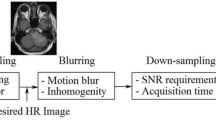Abstract
Dynamic contrast-enhanced MRI (DCE-MRI) plays an important role as an imaging method for the diagnosis and evaluation of several diseases. Indeed, clinically relevant, per-voxel quantitative information may be extracted through the analysis of the enhanced MR signal. This paper presents a method for the automated analysis of DCE-MRI data that works by decomposing the enhancement curves as sparse linear combinations of elementary curves learned without supervision from the data. Experimental results show that performances in denoising and unsupervised segmentation improve over parametric methods.
Access this chapter
Tax calculation will be finalised at checkout
Purchases are for personal use only
Preview
Unable to display preview. Download preview PDF.
Similar content being viewed by others
References
Agner, S., et al.: Segmentation and classification of triple negative breast cancers using DCE-MRI. In: Proc. IEEE ISBI 2009, pp. 1227–1230 (2009)
Aharon, M., et al.: K-SVD: An algorithm for designing overcomplete dictionaries for sparse representation. IEEE Transactions on Signal Processing 54(11) (2006)
Alonzi, R., Padhani, A.R., Allen, C.: Dynamic contrast enhanced MRI in prostate cancer. Eur. J. Radiol. 63(3), 335–350 (2007)
Bishop, C.: Pattern Recognition and Machine Learning. Springer, Heidelberg (2006)
Crum, W., et al.: Generalized overlap measures for evaluation and validation in medical image analysis. IEEE TMI 25(11), 1451–1461 (2006)
Damasio, M.B., Malattia, C., Martini, A., Tomà, P.: Synovial and inflammatory diseases in childhood: role of new imaging modalities in the assessment of patients with juvenile idiopathic arthritis. Pediatric Radiology 40(6), 985–998 (2010)
Guo, J., Reddick, W.: DCE-MRI pixel-by-pixel quantitative curve pattern analysis and its application to osteosarcoma. Journal of MR 30(1), 177–184 (2009)
Harris, N., Gauden, V., Fraser, P., Williams, S., Parker, G.: MRI measurement of blood-brain barrier permeability following spontaneous reperfusion in the starch microsphere model of ischemia. Magnetic Resonance Imaging 20(3), 221–230 (2002)
Kubassova, O., Boesen, M., Boyle, R.D., Cimmino, M.A., Jensen, K.E., Bliddal, H., Radjenovic, A.: Fast and robust analysis of dynamic contrast enhanced MRI datasets. In: Ayache, N., Ourselin, S., Maeder, A. (eds.) MICCAI 2007, Part II. LNCS, vol. 4792, pp. 261–269. Springer, Heidelberg (2007)
Lavini, C., et al.: Pixel-by-pixel analysis of DCE MRI curve patterns and an illustration of its application to the imaging of the musculoskeletal system. Magnetic Resonance Imaging 25(5), 604–612 (2007)
Lee, H., Battle, A., Raina, R., Ng, A.: Efficient sparse coding algorithms. In: Advances in Neural Information Processing Systems, NIPS 2006, vol. 19 (2006)
Mairal, J., Bach, F., Ponce, J., Sapiro, G.: Online learning for matrix factorization and sparse coding. Journal of Machine Learning Research 11, 19–60 (2010)
Olshausen, B., Field, D.: Sparse coding with an overcomplete basis set: A strategy employed by V1? Vision Research 37(23), 3311–3325 (1997)
Schmid, V.J., et al.: Quantitative analysis of dynamic contrast-enhanced MR images based on bayesian p-splines. IEEE TMI 28(6), 789–798 (2009)
Staglianò, A., Chiusano, G., Basso, C., Santoro, M.: Learning adaptive and sparse representations of medical images. In: Menze, B., Langs, G., Tu, Z., Criminisi, A. (eds.) MICCAI 2010. LNCS, vol. 6533, pp. 130–140. Springer, Heidelberg (2011)
Vivier, P., Blondiaux, E., Dolores, M., Marouteau-Pasquier, N., Brasseur, M., Petitjean, C., Dacher, J.: Functional mr urography in children. J. Radiol. (2009)
Yang, J., Yu, K., Gong, Y., Huang, T.: Linear spatial pyramid matching using sparse coding for image classification. In: IEEE Conference on Computer Vision and Pattern Recognition, CVPR 2009, pp. 1794–1801 (June 2009)
Zöllner, F.G., et al.: Assessment of 3D DCE-MRI of the kidneys using non-rigid image registration and segmentation of voxel time courses. Computerized Medical Imaging and Graphics 33(3), 171–181 (2009)
Author information
Authors and Affiliations
Editor information
Editors and Affiliations
Rights and permissions
Copyright information
© 2011 Springer-Verlag Berlin Heidelberg
About this paper
Cite this paper
Chiusano, G., Staglianò, A., Basso, C., Verri, A. (2011). DCE-MRI Analysis Using Sparse Adaptive Representations. In: Suzuki, K., Wang, F., Shen, D., Yan, P. (eds) Machine Learning in Medical Imaging. MLMI 2011. Lecture Notes in Computer Science, vol 7009. Springer, Berlin, Heidelberg. https://doi.org/10.1007/978-3-642-24319-6_9
Download citation
DOI: https://doi.org/10.1007/978-3-642-24319-6_9
Publisher Name: Springer, Berlin, Heidelberg
Print ISBN: 978-3-642-24318-9
Online ISBN: 978-3-642-24319-6
eBook Packages: Computer ScienceComputer Science (R0)




